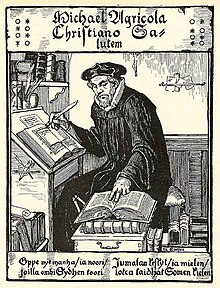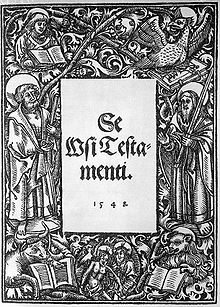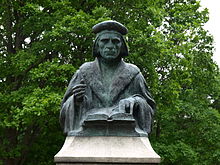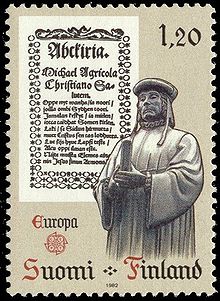Mikael Agricola

Mikael Agricola ( ; actually Mikael Olavinpoika , "son of Olav"; * around 1509 in Pernå (Finnish. Pernaja); † April 9, 1557 in Uusikirkko / Nykyrka ) was a Finnish theologian and reformer and is considered the father of Finnish literary language .
Life
Agricola was the son of a farmer and was born in the southern Finnish parish of Pernaja , probably in the village of Torsby. He grew up bilingual with Swedish and Finnish, although according to the findings of Simo Heininen's studies, Swedish is to be regarded as his mother tongue.
Agricola attended the Latin school with Johannes Erasmus in Viipuri (Schw. Wiborg or Viborg) and there came into contact with ideas of humanism and the Reformation for the first time . In 1528 he was ordained and went to Turku (Schw. Åbo) as secretary to Bishop Martin Skytte . In Turku he made the acquaintance of Petrus Särkilax , a student of Erasmus and Luther . It was also in Turku that in 1531 he adopted the Latin surname Agricola ("farmer") instead of his father's name Olavinpoika.
Bishop Skytte sent Agricola to study at the university in Wittenberg in 1536 . There he became a pupil of Melanchthon , Bugenhagen and Luther, from whom he had already acquired in Turku in 1531 a copy of the Enarrationes seu postillae in lectiones published in Strasbourg the previous year . In 1539 Agricola finished his studies with a master's degree and returned to Finland .
After returning to Turku, he became a canon in the cathedral chapter and rector of the Turku Latin School, which he headed until 1548. In 1548 he was first coadjutor of Bishop Skyttes and, after his death in 1550, without papal approval, his successor. In this office he stood up for the interests of the Reformation more decisively than his predecessor.
Agricola was not only an important theological author and translator, but also a careful administrator: his handwritten records of the income of the cathedral chapter and the parish in Turku were published by Jyrki Knuutila and Anneli Mäkelä-Alitalo in 2007 on the occasion of the Agricola year. He also worked as a politician and diplomat. In 1557 he was a member of an embassy of the Swedish king at the court of Ivan the Terrible in the peace negotiations between Sweden and Russia. On the way back from Russia Agricola died in Finland, probably in Uusikirkko. He was buried in Viipuri / Wiborg Cathedral. The exact burial place in the cathedral is no longer known.
Agricola married Birgitta Olavintytär (= daughter of Olav; † 1595) in 1549 or 1550. His only son Christian Agricola (born December 11, 1550, † February 19, 1586) was ordained bishop of Reval ( Tallinn ) in 1583 in Uppsala Cathedral. Christian Agricola was married to the noblewoman Elin Pedersdotter Fleming (d. 1608) and had a daughter with her. The male line of Michael Agricola's descendants became extinct with the death of his son.
plant
Like Luther, Agricola is considered to be the father of the Finnish literary language, which was based on the Turku dialect , expanded to include elements from other Finnish dialects and borrowed from German, Swedish and Latin in particular, and from Agricola and his successors to numerous new formations for theological and scientific needs.
With Sweden and Finland turning to the Reformation, the task also arose there of conveying the faith to the people in their own language. Sermons and prayers in the Finnish language also existed in the time before Agricola, but it was he who programmatically justified the Reformation concerns for the Finnish language and put it into practice. His first printed work was also the first book printed in Finnish, the ABC-kirja (ABC book), which was written between 1537 and 1543 and was probably printed for the first time in 1543, in a second edition in 1551 and in a posthumous third in 1559 Edition appeared. This is not a catechism for beginners, but a collection of basic Christian texts a. based on Luther's Small Catechism and Philipp Melanchthon's Catechism. The ABC-Kiria contains u. a. the creed , the Lord's Prayer , and declarations of baptism and the Lord's Supper . The existence of the ABC-Kiria only became known again in 1851 through the discovery of a title page in the University Library of Uppsala, further parts were discovered in 1904 in the Swedish State Archives and in 1966 in the Diocesan Library of Västerås .
In 1544 Agricola in Stockholm published Rucouskiria Bibliasta , a prayer book based on texts from the Bible. His most important achievement, however, was the translation of the New Testament ( Se Wsi Testamenti ). The beginning of this translation work can be traced back to the time in Turku before the beginning of his studies in Wittenberg by means of handwritten glosses in his books. It was completed in 1543 and published in Stockholm in 1548. Its translation followed the original Greek text, but it also drew on the Latin translation by Erasmus, the German by Martin Luther and the Swedish by Olaus Petri .
In 1549 his Finnish adaptation of the Mass liturgy ( Messu eli Herran Echtolinen ) appeared, which, in contrast to the Danish-Norwegian (1537/42) and Icelandic (1594), does not belong to the type established by Bugenhagen, but as an adaptation of the Swedish mass by Olaus Petri (1531 ) follows a tradition that originated in Nuremberg in 1524/25, which was conveyed to Sweden via a Low German version of the Nuremberg hospital fair Andreas Döbers used in Rostock .
In 1551 he published a translation of the Psalms ( Dauidin Psalttari ), which was followed by further translations from the Old Testament in 1551 and 1552 . In the introduction to his translation of the Psalms, he also offered a metrical enumeration of indigenous pagan deities Hämes and Karelia , which is the most important source of Finnish mythology and folk lore in the 16th century. In his forewords he also added rhyming poems that are written in three- or four-footed iambic rhyming verses and are based on the example of the German Knittel verse .
Afterlife
No contemporary pictorial representations have come down to us from Mikael Agricola. The various statues (e.g. in the Helsinki Cathedral , in and in front of the Turku Cathedral) and pictorial representations of the Finnish reformer (e.g. the picture of Albert Edelfelt ) are inventions of the 19th and 20th centuries. In Wittenberg, two plaques (a bronze plaque on the Luther House and an enamel plaque on the former university building) commemorate Agricola's studies in this city.
The well-known Finnish poet and playwright Paavo Haavikko placed Agricola at the center of his 1968 drama Agricola ja kettu ("Agricola and the Fox"), which made Agricola stand up for the rights of Finland in the power struggle between Sweden and Russia and, in a more general sense, the implication of the Represents intellectuals in the political intrigues of his time. The world premiere in Helsinki caused a sensation because the director Kalle Holmberg had the actor Ivan the Terrible costumed after the model of Josef Stalin to underline the references to the current political situation in Finland in the conflict between East and West .
Memorial days
In Finland, April 9th is Mikael Agricola Day and Finnish Language Day.
The Evangelical Lutheran Church in America has established a memorial day for Mikael Agricola on April 10th .
Agricola's writings
- ABC Kiria. approx. 1543 ( PDF; 1.5 MB ). Critical edition by Kaisa Häkkinen, SKS, Helsinki 2007.
- Rucouskiria Bibliasta. 1544 ( PDF; 84.5 MB )
- Se Wsi Testamenti , 1548 ( PDF; 148.2 MB )
- Käsikiria Castesta ia muista Christikunnan Menoista. 1549.
- Messu eli Herran Echtolinen. 1549.
- Se avoid Herran Jesusen Christs Pina, ylesnousemus ia taiuaisen Astumus, nest Neliest Euangelisterist coghottu. 1549.
- Dauidin Psalttari. 1551 ( PDF; 44.72 MB ). Critical edition by Simo Heininen, Suomalaisen Kirjallisuuden Seura, Helsinki 1994.
- Weisut ia Ennusttoxet Mosesen Laista ia Prophetista Wloshaetut. 1551.
- Ne prophet. Haggai. Zechariah. Malachi. 1552.
literature
- Otfried Czaika: Det kollektiva minnet av reformationen och Mikael Agricola i 2000-talets Finland. (PDF; 279 kB) In: BIBLIS 46. Stockholm 2009, pp. 15–25.
- Otfried Czaika: Plinius världshistoria med Agricolas ägaranteckning . In: BIBLIS 51. Stockholm 2010, pp. 30–39.
- Jaakko Gummerus: Michael Agricola, the reformer of Finland. Luther-Agricola-Ges., Helsinki 1941.
- Simo Heininen: Mikael Agricola raamatunsuomentajana. SKS, Helsinki 1999.
- Simo Heininen: Mikael Agricola. Elämä yes teokset. Edita, SKS 2007.
- Jyrki Knuutila, Anneli Mäkelä-Alitalo: Mikael Agricola. Turun Tuomiokirkon ja Papiston tulot 1541-1542. SKS, Helsinki 2007.
- Anna Perälä: Mikael Agricolan teosten painoasu ja kuvitus. SKS, Helsinki 2007.
- Kari Tarkiainen: Ruotsin ja Venäjän rauhanneuvottelut 1557. SKS, Helsinki 2007.
- Artur Hjelt: Mikael Agricola, the first Finnish Bible translator. Deichert, Leipzig 1908.
- Heinz Scheible: Melanchthon's Correspondence People Volume 11.
Web links
- Page on the Agricola commemorative year (also in German)
Individual evidence
- ↑ Simo Heininen: Mikael Agricoa: Elämä ja Teokset. Helsinki 2007, p. 26.
- ^ Karl-Heinrich Bieritz : Liturgy. de Gruyter, Berlin / New York 2004, ISBN 3-11-013236-2 , p. 468, p. 459.
- ↑ Elke Strauchenbruch: Who Was Where in Wittenberg? - Interesting facts about 99 memorial plaques. ISBN 3-933028-80-8 , p. 11.
- ↑ April 10 in the ecumenical dictionary of saints
| predecessor | Office | successor |
|---|---|---|
| Martti Skytte |
Bishop of Turku 1554 - 1557 |
Pietari Follingius |
| personal data | |
|---|---|
| SURNAME | Agricola, Mikael |
| ALTERNATIVE NAMES | Olavinpoika, Mikael (maiden name) |
| BRIEF DESCRIPTION | Finnish theologian and reformer |
| DATE OF BIRTH | around 1509 |
| PLACE OF BIRTH | Pernaya |
| DATE OF DEATH | April 9, 1557 |
| Place of death | Uusikirkko |



